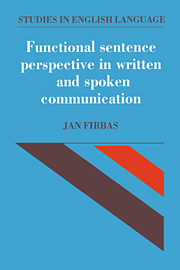Book contents
- Frontmatter
- Contents
- Preface
- List of abbreviations
- Part I Functional sentence perspective in written communication
- Part II Functional sentence perspective in spoken communication
- 8 Non-prosodic distribution of degrees of communicative dynamism and degrees of prosodic prominence
- 9 Some more observations on the relationship between the non-prosodic distribution of communicative dynamism and that of prosodic prominence
- 10 Analyses of two spoken texts
- 11 Some special issues concerning functional sentence perspective in the spoken language
- References
- Index
11 - Some special issues concerning functional sentence perspective in the spoken language
Published online by Cambridge University Press: 19 November 2009
- Frontmatter
- Contents
- Preface
- List of abbreviations
- Part I Functional sentence perspective in written communication
- Part II Functional sentence perspective in spoken communication
- 8 Non-prosodic distribution of degrees of communicative dynamism and degrees of prosodic prominence
- 9 Some more observations on the relationship between the non-prosodic distribution of communicative dynamism and that of prosodic prominence
- 10 Analyses of two spoken texts
- 11 Some special issues concerning functional sentence perspective in the spoken language
- References
- Index
Summary
The foregoing discussions enable me to formulate my view of the contextual applicability of the spoken sentence structure, answer the question whether CD can be equated with PP, summarize the role of intonation in FSP, subscribe to Vachek's assessment of the relationship between the written language and the spoken language, account for the concept of potentiality and assess the role of the contextual factor in FSP.
Functional sentence perspective and the contextual applicability of the spoken sentence structure
Discussing FSP in written communication, I posed the question of the contextual applicability in FSP of the written semantic and grammatical sentence structure. Let me now add a note on FSP contextual applicability in the spoken language. An enquirer into contextual applicability is free to choose the structure, the applicability of which he wishes to assess; but in doing so, he has to determine which features are to be regarded as constitutive, i.e. as identifying the structure.
Examining the contextual applicability in FSP of a written sentence structure on pages 110–14, I regarded the words used, their syntactic implementation, their linear arrangement and – if employed – their typographical intensification (its italicization, for instance) as such constitutive features. A different word and/or another syntactic implementation and/or a change in word order and/or a difference in typographical intensification would have created a different sentence structure.
Examining the contextual applicability in FSP of a spoken sentence structure, I exclude from the features just enumerated the signals of typographical intensifications, but add the PP distribution.
- Type
- Chapter
- Information
- Publisher: Cambridge University PressPrint publication year: 1992



